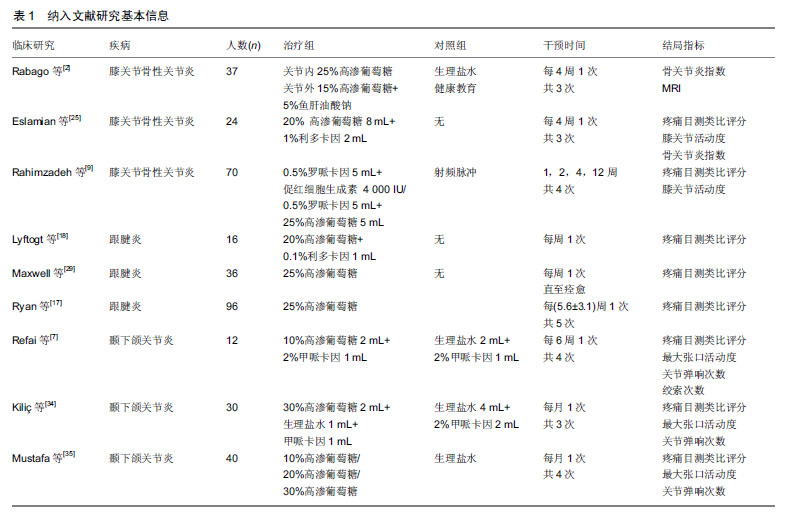| [1]Fullerton BD.Prolotherapy for the Thoracolumbar Myofascial System. Phys Med RehabilClin N Am.2018, 29(1):125-138.[2]Rabago D,Nourani B.Prolotherapy for Osteoarthritis and Tendinopathy: a Descriptive Review. Curr Rheumatol Rep. 2017; 19(6):34.[3]Sanderson LM, Bryant A. Effectiveness and safety of prolotherapy injections for management of lower limb tendinopathy and fasciopathy: a systematic review. J Foot Ankle Res. 2015 ;8:57. [4]Nourani B,Rabago D. Prolotherapy for Knee Osteoarthritis: A Descriptive Review. Curr Phys Med Rehabil Rep.2016; 4(1):42-49.[5]Derakhshan P . What is the role of erythropoietin prolotherapy on pain relief of knee osteoarthritis?. J Res Med Sci. 2018 6;23:50.[6]Ryu K, Ko D, Lim G,et al.Ultrasound-Guided Prolotherapy with Polydeoxyribonucleotide for Painful Rotator Cuff Tendinopathy. Pain Res Manag. 2018;2018:8286190..[7]Refai H.Long-term therapeutic effects of dextrose prolotherapy in patients with hypermobility of the temporomandibular joint: a single-arm study with 1-4 years’ follow up. Br J Oral Maxillofac Surg. 2017;55(5):465-470.[8]Rabago D, Slattengren A, Zgierska A. Prolotherapy in Primary Care Practice. Prim Care. 2010;37(1):65-80.[9]Rahimzadeh P, Imani F, Faiz SH, et al. Investigation the efficacy of intra-articular prolotherapy with erythropoietin and dextrose and intra-articular pulsed radiofrequency on pain level reduction and range of motion improvement in primary osteoarthritis of knee. J Res Med Sci. 2014;19(8):696-702.[10]Park YS, Lim SW, Lee IH, et al. Intra-articular injection of a nutritive mixture solution protects articular cartilage from osteoarthritic progression induced by anterior cruciate ligament transection in mature rabbits: a randomized controlled trial. Arthritis Res Ther. 2007;9(1):R8.[11]Jensen KT, Rabago DP, Best TM, et al. Early inflammatory response of knee ligaments to prolotherapy in a rat model. J Orthop Res. 2008;26(6):816-823.[12]Chan O, Havard B, Morton S, et al. Outcomes of prolotherapy for intra-tendinous Achilles tears: a case series. Muscles Ligaments Tendons J. 2017 ;7(1):78-87.[13]Wu TJ,Fong YC,Lin CY,et al.Glucose enhances aggrecan expression in chondrocytes via the PKCα/p38-miR141-3p signaling pathway. J Cell Physiol. 2018;233(9):6878-6887.[14]Derby B M ,Reichensperger J , Chambers C , et al. Early Growth Response Factor-1: Expression in a Rabbit Flexor Tendon Scar Model. Plast Reconstr Surg. 2012;129(3):435e-442e. [15]Hoksrud A,Ohberg L,Alfredson H,et al.Ultrasound-guided sclerosis of neovessels in painful chronic patellar tendinopathy: a randomized controlled trial. Am J Sports Med. 2006;34(11):1738-1746.[16]Burdakov D, Jensen L T, Alexopoulos H, et al. Tandem-Pore K +, Channels Mediate Inhibition of Orexin Neurons by Glucose. Neuron. 2006;50(5):711-722.[17]Ryan M, Wong A. Ultrasound-guided injections of hyperosmolar dextrose for overuse patellar tendinopathy: a pilot study.Br J Sports Med.2011;45(12):972-977.[18]Lyftogt J. Subcutaneous prolotherapy treatment of refractory knee, shoulder, and lateral elbow pain. Australasian Musculoskeletal Medicine. 2007; 12(2):202-210.[19]Veronesi B,Oortgiesen M.Neurogenic Inflammation and Particulate Matter (PM) Air Pollutants. Neurotoxicology, 2001; 22(6):795-810.[20]Tsai CH, Chiang YC, Chen HT, et al. High glucose induces vascular endothelial growth factor production in human synovial fibroblasts through reactive oxygen species generation. Biochim Biophys Acta. 2013;1830(3):2649-2658.[21]Ashraf S, Walsh DA. Angiogenesis in osteoarthritis. Curr Opin Rheumatol. 2008;20(5):573-580.[22]Ismail HM, Yamamoto K, Vincent TL, et al. Interleukin-1 Acts via the JNK-2 Signaling Pathway to Induce Aggrecan Degradation by Human Chondrocytes. Arthritis Rheumatol. 2015;67(7):1826-1836.[23]Dagenais S,Ogunseitan O,Haldeman S, et al. Side Effects and Adverse Events Related to Intraligamentous Injection of Sclerosing Solutions (Prolotherapy) for Back and Neck Pain: A Survey of Practitioners. Arch Phys Med Rehabil. 2006;87(7):909-913.[24]Vora A,Borg-Stein J, Nguyen R T. Regenerative injection therapy for osteoarthritis: fundamental concepts and evidence-based review. PM R. 2012;4(5 Suppl):S104-S109.[25]Rabago D,Kijowski R, Woods M, et al. Association between disease-specific quality-of-life and magnetic resonance imaging outcomes in a clinical trial of prolotherapy for knee osteoarthritis. Arch Phys Med Rehabil. 2013;94(11):2075-2082.[26]Eslamian F, Amouzandeh B. Therapeutic effects of prolotherapy with intra-articular dextrose injection in patients with moderate knee osteoarthritis: a single-arm study with 6 months follow up. Ther Adv Musculoskelet Dis. 2015;7(2):35-44.[27]Jean-Paul Ouellette,Jeffrey J.Patterson,George Yu,许涛. 增生疗法[J]. 实用疼痛学杂志,2006,2(1):3-9.[28]Lyftogt J. Prolotherapy and Achilles tendinopathy: a prospective pilot study of an old treatment. Australasian Musculoskeletal Medicine. 2005;10(1):12-16.[29]Maxwell NJ, Ryan MB, Taunton JE, et al. Sonographically Guided Intratendinous Injection of Hyperosmolar Dextrose to Treat Chronic Tendinosis of the Achilles Tendon: A Pilot Study. Ajr Am J Roentgenol. 2007; 189(4):215-220.[30]Ryan M,Wong A,Taunton J.Favorable Outcomes After Sonographically Guided Intratendinous Injection of Hyperosmolar Dextrose for Chronic Insertional and Midportion Achilles Tendinosis. AJR Am J Roentgenol. 2010;194(4):1047-1053.[31]Schultz LW. A Treatment for subluxation of the Temporomandibular Joint. JAMA.1937; 109(12):1947-1950.[32]Nagori SA, Jose A, Gopalakrishnan V, et al. Roy ID The efficacy of dextrose prolotherapy over placebo for temporomandibular joint hypermobility: a systematic review and meta-analysis. J Oral Rehabil. 2018;45(12):998-1006.[33]Refai H,Altahhan O,Elsharkawy R.The efficacy of dextrose prolotherapy for temporomandibular joint hypermobility: a preliminary prospective, randomized, double-blind, placebo- controlled clinical trial.J Oral Maxillofac Surg. 2011;69(12): 2962-2970.[34]Kiliç SC, Güngörmü? M. Is dextrose prolotherapy superior to placebo for the treatment of temporomandibular joint hypermobility? A randomized clinical trial. Int J Oral Maxillofac Surg. 2016;45(7): 813-819.[35]Mustafa R,Güngörmü? M,Mollao?lu N.Evaluation of the Efficacy of Different Concentrations of Dextrose Prolotherapy in Temporomandibular Joint Hypermobility Treatment. J Craniofac Surg. 2018;29(5):e461-e465.[36]Umlauf D,Frank S,Pap T,et al.Cartilage biology, pathology, and repair. Cell Mol Life Sci. 2010;67(24):4197-4211.[37]Clifton T,Selby M.Epidural abscess from prolotherapy: a cautionary tale. ANZ J Surg. 2018;88(3):E216-E217. .[38]刘伟,陈世荣.不同支架材料与间充质干细胞构建组织工程韧带在前交叉韧带损伤中的应用[J]. 中国组织工程研究, 2011,15(38):7181-7184.[39]侯存强,周宪华,孙磊. 骨骼肌对前交叉韧带重建腱性移植物关节内愈合效果的影响[J].中国骨科临床与基础研究杂志, 2012,4(2):133-137.[40]Sahr M, Sturnick DR, Nwawka OK. Quantitative Ultrasound Assessment of the Achilles Tendon Under Varied Loads. J Ultrasound Med. 2018;(3):13-23. |
.jpg) 文题释义:
可聚蛋白多糖(aggrecan):是一种蛋白多糖大分子,它由糖胺多糖和核心蛋白组成。可聚蛋白多糖与透明质酸以非共价键结合,形成蛋白多糖聚合体,是软骨细胞外基质的主要结构成分之一。它与胶原网络结合使得软骨具有弹性、能够承担负荷,并有自我润滑的性能。蛋白多糖的进行性丧失是骨关节病的特点之一。
渗透休克法(osmotic shock):或称“冷休克”的方法。此法是根据突然改变渗透压并使细胞发生物理性裂解的原理。例如周质蛋白渗透休克法:其主要步骤是:将细菌放在用Tris缓冲液配制、含EDTA的20%蔗糖溶液中保温,使其发生质壁分离,接着快速地用4 ℃的0.005 mol/L的MgCl2溶液稀释并降温,使细胞外膜(细菌外膜)突然破裂并释放周质蛋白。经离心即可从上清液中提取周质蛋白。
文题释义:
可聚蛋白多糖(aggrecan):是一种蛋白多糖大分子,它由糖胺多糖和核心蛋白组成。可聚蛋白多糖与透明质酸以非共价键结合,形成蛋白多糖聚合体,是软骨细胞外基质的主要结构成分之一。它与胶原网络结合使得软骨具有弹性、能够承担负荷,并有自我润滑的性能。蛋白多糖的进行性丧失是骨关节病的特点之一。
渗透休克法(osmotic shock):或称“冷休克”的方法。此法是根据突然改变渗透压并使细胞发生物理性裂解的原理。例如周质蛋白渗透休克法:其主要步骤是:将细菌放在用Tris缓冲液配制、含EDTA的20%蔗糖溶液中保温,使其发生质壁分离,接着快速地用4 ℃的0.005 mol/L的MgCl2溶液稀释并降温,使细胞外膜(细菌外膜)突然破裂并释放周质蛋白。经离心即可从上清液中提取周质蛋白。
.jpg)
.jpg) 文题释义:
可聚蛋白多糖(aggrecan):是一种蛋白多糖大分子,它由糖胺多糖和核心蛋白组成。可聚蛋白多糖与透明质酸以非共价键结合,形成蛋白多糖聚合体,是软骨细胞外基质的主要结构成分之一。它与胶原网络结合使得软骨具有弹性、能够承担负荷,并有自我润滑的性能。蛋白多糖的进行性丧失是骨关节病的特点之一。
渗透休克法(osmotic shock):或称“冷休克”的方法。此法是根据突然改变渗透压并使细胞发生物理性裂解的原理。例如周质蛋白渗透休克法:其主要步骤是:将细菌放在用Tris缓冲液配制、含EDTA的20%蔗糖溶液中保温,使其发生质壁分离,接着快速地用4 ℃的0.005 mol/L的MgCl2溶液稀释并降温,使细胞外膜(细菌外膜)突然破裂并释放周质蛋白。经离心即可从上清液中提取周质蛋白。
文题释义:
可聚蛋白多糖(aggrecan):是一种蛋白多糖大分子,它由糖胺多糖和核心蛋白组成。可聚蛋白多糖与透明质酸以非共价键结合,形成蛋白多糖聚合体,是软骨细胞外基质的主要结构成分之一。它与胶原网络结合使得软骨具有弹性、能够承担负荷,并有自我润滑的性能。蛋白多糖的进行性丧失是骨关节病的特点之一。
渗透休克法(osmotic shock):或称“冷休克”的方法。此法是根据突然改变渗透压并使细胞发生物理性裂解的原理。例如周质蛋白渗透休克法:其主要步骤是:将细菌放在用Tris缓冲液配制、含EDTA的20%蔗糖溶液中保温,使其发生质壁分离,接着快速地用4 ℃的0.005 mol/L的MgCl2溶液稀释并降温,使细胞外膜(细菌外膜)突然破裂并释放周质蛋白。经离心即可从上清液中提取周质蛋白。